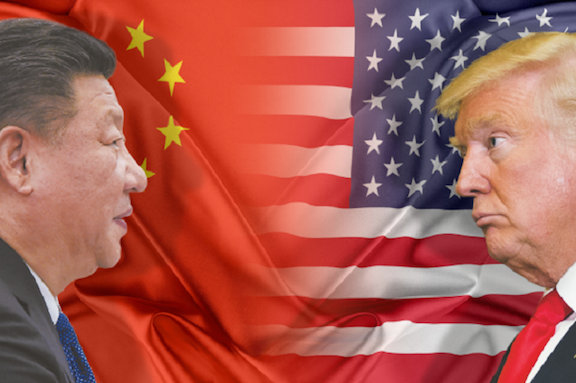The trade war between the U.S. and China is about to get uglier. After a long, hot summer spent weighing risks and firing warning shots, the hawks in President Donald Trump’s administration have gained the upper hand—and they’re set to unleash a fall offensive.

Talks in Washington this week yielded little visible progress toward a cease-fire between the world’s two largest economies. Looming instead are new tariffs that Trump has threatened to impose on some $200 billion in annual imports from China, and Beijing’s already-promised retaliation.
Even before the latest talks broke up, the signals weren’t hard to read. Earlier this year, the president publicly overruled Steven Mnuchin and ripped up a deal the Treasury secretary had struck with Liu He, his Chinese counterpart.
Hawks Won
In the past week, while the two sides were talking, the U.S. went ahead with tariffs on a further $16 billion in Chinese imports. Retaliation by Beijing will bring the amount of trade affected by the dispute to $100 billion, with more to come.
Trump also celebrated new restrictions on inbound investment from China this week.
“Not enough focus has been put on China. And that’s been for a long time,” the president told legislators gathered at the White House on Thursday to mark the passage of a law giving yet more powers to the already powerful Committee on Foreign Investment in the U.S., which can block acquisitions on national security grounds.
And on Friday, Trump’s officials were huddled in Washington with counterparts from Europe and Japan, discussing how to push China into changing course.
It all adds up to what many analysts see as a victory for the president’s China hawks, in the debate over how to tackle the first major strategic rival the U.S. has faced since the end of the Cold War.
‘Spectrum Shift’
Scott Kennedy, a China expert at the Center for Strategic and International Studies in Washington, says the hawks’ victory is reflected in the way U.S. demands have evolved in recent weeks.
When Mnuchin and Commerce Secretary Wilbur Ross led missions to Beijing earlier this year, one key priority was securing increased purchases of American soybeans, LNG and other commodities, to reduce a bilateral trade deficit that’s been a persistent obsession for Trump.
A few months on, the administration’s goals are more maximal. It’s demanding the kind of long-term structural changes to Chinese policy—such as ending industrial subsidies and intellectual-property theft—that hawks including Robert Lighthizer, the U.S. trade representative, and White House trade adviser Peter Navarro have been pushing for. “A spectrum shift,” Kennedy calls it.
That doesn’t mean that internal trade battles at the White House are over. The hawks are eyeing an even more ambitious agenda, says Kennedy: A long-term disentanglement of the two economies, with the goal of bringing supply chains back from Asia to the U.S.
‘Like My Mom’
Chad Bown, a trade expert at the Peterson Institute for International Economics, says the administration’s end-game remains unclear.
At home, there’s growing unrest in the business community and among consumers. In hearings this week, a procession of small and medium-sized companies complained about the forthcoming tranche of tariffs, which will hit some 6,000 products ranging from seafood to bicycles.
Bown has seen firsthand how the dispute has arrived in American homes. Tariffs are about to make his mother’s quilting supplies more expensive—and “there’s a big community of quilters out there like my mom.”
“More and more Americans are going to feel this,” he says. “We haven’t gone through a moment like this before. Politically, I’m not sure how it ends.”
‘So Far’
The rude health of the U.S. economy is probably giving Trump room to escalate. Businesses may complain about tariffs, but they’re also reaping the benefits of the president’s tax cuts. Dollar, the Brookings analyst, says the real economic effect of Trump’s trade moves may not be felt until well into 2019.
Federal Reserve policy makers have flagged a trade war as a major risk to the economy—but one that’s still over the horizon. On Friday, Fed Chairman Jerome Powell predicted more “strong growth” accompanied by gradual interest-rate increases. He didn’t mention trade at all.
Loretta Mester, president of the Cleveland Fed, told Bloomberg TV in an interview that policy makers need to keep a close eye on how U.S. business responds to the tariffs. In her own district, said Mester, companies are studying their impact.
“But so far they haven’t reacted strongly,” she said. “They haven’t taken off investment that they had planned.”





_-_127500_-_1da204f56eddee4a9ff1d6f8fe7f7f4e89a54723_lqip.jpg)



